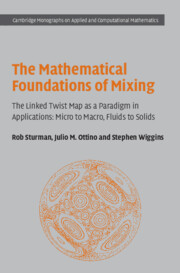 The Mathematical Foundations of Mixing
The Mathematical Foundations of Mixing Book contents
- Frontmatter
- Contents
- Preface
- Acknowledgments
- 1 Mixing: physical issues
- 2 Linked twist maps: definition, construction and the relevance to mixing
- 3 The ergodic hierarchy
- 4 Existence of a horseshoe for the linked twist map
- 5 Hyperbolicity
- 6 The ergodic partition for toral linked twist maps
- 7 Ergodicity and the Bernoulli property for toral linked twist maps
- 8 Linked twist maps on the plane
- 9 Further directions and open problems
- References
- Index
9 - Further directions and open problems
Published online by Cambridge University Press: 03 February 2010
- Frontmatter
- Contents
- Preface
- Acknowledgments
- 1 Mixing: physical issues
- 2 Linked twist maps: definition, construction and the relevance to mixing
- 3 The ergodic hierarchy
- 4 Existence of a horseshoe for the linked twist map
- 5 Hyperbolicity
- 6 The ergodic partition for toral linked twist maps
- 7 Ergodicity and the Bernoulli property for toral linked twist maps
- 8 Linked twist maps on the plane
- 9 Further directions and open problems
- References
- Index
Summary
We conclude by identifying some directions in which this work could and should be extended. In particular we discuss issues of optimization of size of mixing regions, lack of transversality in streamline crossing, and breakdown of monotonicity for twist functions.
Introduction
In this final chapter we discuss some of the open questions connected with the linked twist map approach to mixing. It is apparent that in terms of designing, creating and optimizing mixers this approach is still very much in its infancy. Translating the ideas of previous chapters into ‘design’ principles is itself a sizeable task, and may result in the theory being extended in a variety of interesting directions. We mention only a few here.
In Section 9.2 we consider the question of how to optimize the size of domain on which the Bernoulli property is present. We have seen in previous chapters that, providing certain conditions on the properties of the twists are satisfied, the Bernoulli property is enjoyed by almost all points in the union of the annuli. However, we have also seen that the required conditions on the twists are more likely to be satisfied for smaller size domains. For example, recall that a counter-rotating toral linked twist map with linear single-twists is periodic with period 6 when the annuli are equal in size to the torus (see Example 6.4.2), while a linear counter-rotating TLTM may be Bernoulli for a choice of smaller annuli.
- Type
- Chapter
- Information
- The Mathematical Foundations of MixingThe Linked Twist Map as a Paradigm in Applications: Micro to Macro, Fluids to Solids, pp. 240 - 270Publisher: Cambridge University PressPrint publication year: 2006
